Intel's Bean Canyon (NUC8i7BEH) Coffee Lake NUC Review - Ticking the Right Boxes
by Ganesh T S on April 3, 2019 8:00 AM EST- Posted in
- Systems
- Intel
- NUC
- UCFF
- Thunderbolt 3
- Cannon Point
- Coffee Lake-U
BAPCo SYSmark 2018
The Intel NUC8i7BEH (Bean Canyon) was evaluated using our Fall 2018 test suite for small-form factor PCs. In the first section, we will be looking at SYSmark 2018.
BAPCo's SYSmark 2018 is an application-based benchmark that uses real-world applications to replay usage patterns of business users in the areas of productivity, creativity, and responsiveness. The 'Productivity Scenario' covers office-centric activities including word processing, spreadsheet usage, financial analysis, software development, application installation, file compression, and e-mail management. The 'Creativity Scenario' represents media-centric activities such as digital photo processing, AI and ML for face recognition in photos and videos for the purpose of content creation, etc. The 'Responsiveness Scenario' evaluates the ability of the system to react in a quick manner to user inputs in areas such as application and file launches, web browsing, and multi-tasking.
Scores are meant to be compared against a reference desktop (the SYSmark 2018 calibration system, a Dell Optiplex 5050 tower with a Core i3-7100 and 4GB of DDR4-2133 memory to go with a 128GB M.2 SATA III SSD). The calibration system scores 1000 in each of the scenarios. A score of, say, 2000, would imply that the system under test is twice as fast as the reference system.

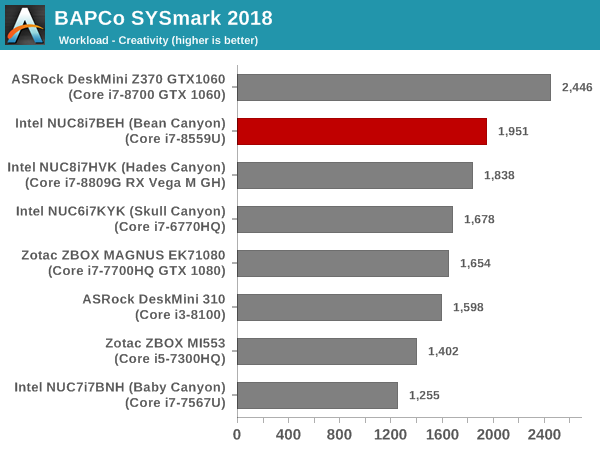

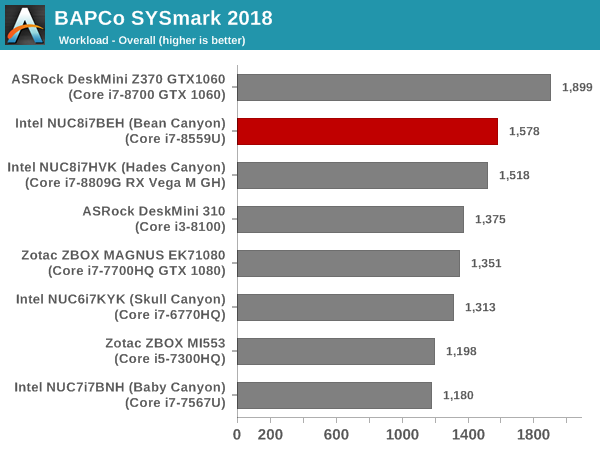
SYSmark 2018 also adds energy measurement to the mix. A high score in the SYSmark benchmarks might be nice to have, but, potential customers also need to determine the balance between power consumption and the efficiency of the system. For example, in the average office scenario, it might not be worth purchasing a noisy and power-hungry PC just because it ends up with a 2000 score in the SYSmark 2014 SE benchmarks. In order to provide a balanced perspective, SYSmark 2018 also allows vendors and decision makers to track the energy consumption during each workload. In the graphs below, we find the total energy consumed by the PC under test for a single iteration of each SYSmark 2018 workload. For reference, the calibration system consumes 5.36 Wh for productivity, 7.71 Wh for creativity, 5.61 Wh for responsiveness, and 18.68 Wh overall.
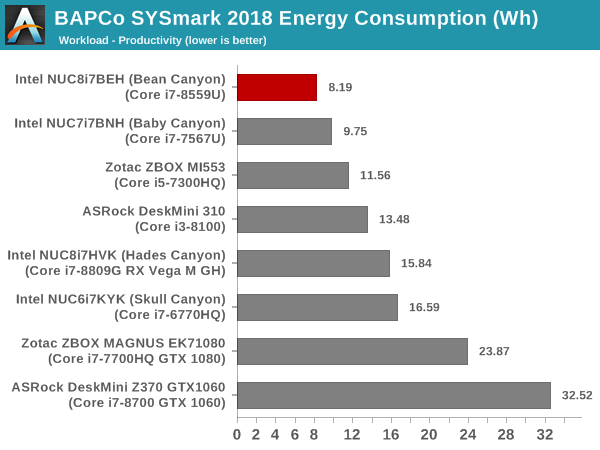
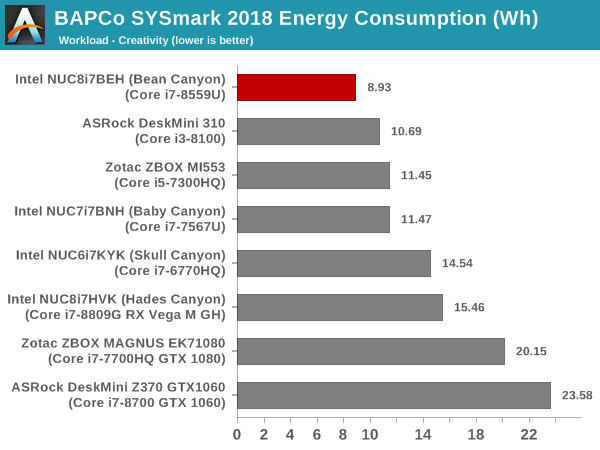
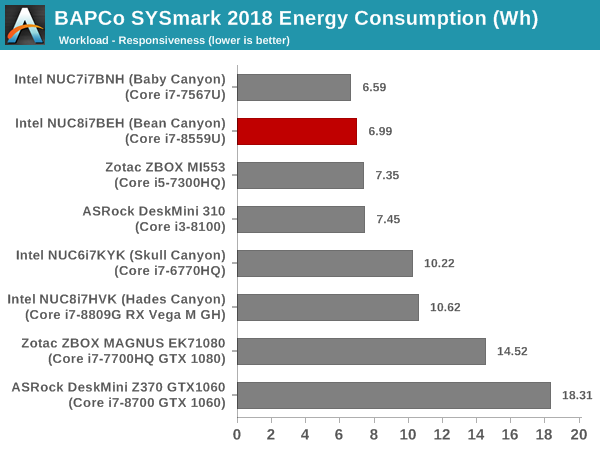
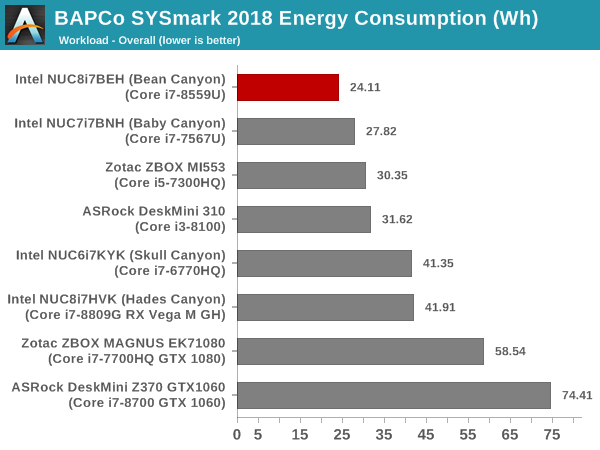
Bean Canyon turns out to be extremely energy efficient compared to almost all of the other PCs that are being compared against it. It loses the performance crown to the hexa-core Core i7-8700-equipped DeskMini Z370 GTX 1060. This is on expected lines, since the Core i7-8700 has a much higher TDP budget compared to the Core i7-8559U. The mini-STX form factor also enables the DeskMini to accommodate a better thermal solution compared to the one in the Intel NUC8i7BEH.










81 Comments
View All Comments
HStewart - Wednesday, April 3, 2019 - link
I think a good NUC will be when Intel has Gen 11 graphics which is suppose to be around NVidia 1030 level but integrated on GPU.Irata - Thursday, April 4, 2019 - link
So the RX Vega 11 iGPU level then ?ab3cv - Wednesday, April 3, 2019 - link
Any idea whether the graphics can support the Dell 49 Ultrasharp with resolution of 5120 x 1440 at 60Hz?Thanks
cacnoff - Wednesday, April 3, 2019 - link
I have tried this monitor on both the Type-C port as well as the HDMI port and both seem to be able to drive the panel at the 5120x1440@60hz resolution just fine. I will have a second panel on thursday to see if it can drive both at the same time fine.jpap - Friday, April 5, 2019 - link
Glad it can drive at least one 512x1440@60 panel. I'm keen to hear if it can drive two simultaneously! That would be one awesome minimal desktop system. :-)ToTTenTranz - Wednesday, April 3, 2019 - link
I for one think it's incredible that the 8559U with a 28W TDP and a GT3 Gen9 is getting practically the same or higher performance than the 6770HQ with a 45W TDP and a GT4 Gen9, considering they're both made on different variations of what's essentially the same node.PeachNCream - Wednesday, April 3, 2019 - link
Yeah, its nice to see the TDP for performance do that sort of thing so clearly. It's also nice that you can now purchase Skull Canyon equivalent power without being forced to have the Skull Canyon name. I was always put off by the whole death and bones branding. It's too visceral and ugly in a world that has enough real life death in it. Bean Canyon sounds a lot better.Ashinjuka - Wednesday, April 3, 2019 - link
I agree. I'm worn away by the mainstreaming of the Death Cult America but I guess that's what tends to happen when a society is imploding.Sailor23M - Wednesday, April 3, 2019 - link
I have a Skull Canyon that I picked up on 25% sale from newegg 2 years ago and its been a solid SFF machine, Intel packages an extra normal (non-skull) lid if you rather use that one. There is a dedicated intel support page for the machine with all drivers and firmware. I have mine mounted behind my monitor for a very clean AIO look with a wireless mouse n keyboard.TheinsanegamerN - Friday, April 5, 2019 - link
The 90's called they want their moral panic back.